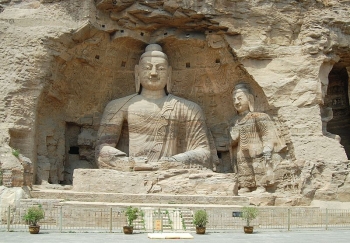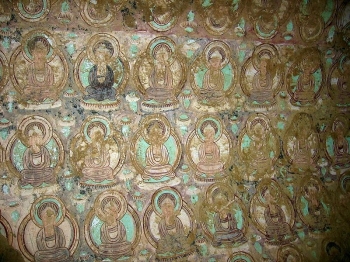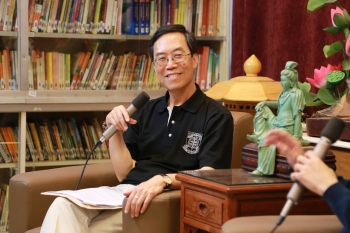Editor's note: “Teachings of Amitabha Buddha” is an inspiring column about the vital spiritual matters of Pure Land Buddhism – from its history, philosophy, and practice to its scriptures and their exegesis and interpretation. The column is penned by Alan Kwan, the founding editor of Buddhistdoor.com.
The eminent master of Pure Land practice, Shandao, highlighted the two teachings of Shakyamuni Buddha and Amitabha Buddha in his Commentary on the Contemplation Sutra. Shakyamuni's is known as the Path of Importance, and the other is the Path of Great Vow by Amitabha Buddha with his alternative intent.
The eminent master of Pure Land practice, Shandao, highlighted the two teachings of Shakyamuni Buddha and Amitabha Buddha in his Commentary on the Contemplation Sutra. Shakyamuni's is known as the Path of Importance, and the other is the Path of Great Vow by Amitabha Buddha with his alternative intent.
He defined the two Paths, and stated as follows:
Path of Importance - The two teachings of meditative virtue and non-meditative virtue, as expounded in the Contemplation Sutra. Meditative virtue means to still one’s mind by ceasing any thought, and non-meditative virtue means to eliminate evil and nurture good. This is the path if one dedicates these two virtues, and aspires to be reborn [in Pure Land].
Path of Great Vow - As written in the Great Sutra (The Infinite Life Sutra), “For all good and evil ordinary beings who are reborn [in Pure Land], they rely on the great vow and pure karmic power of Amitabha Buddha as an augmentative cause.
In the previous articles, the differences between these two teachings in methods, principles, practices have been discussed in detail. Before we discuss further the differences in achievement or reward, it is important to clarify one important point: Are these two paths distinct, independent and separate teachings, or just one, complimentary or supplementary to each other in Pure Land Buddhism?
Can one be reborn in the Pure Land by mere Amitabha-recitation?
First of all, the prime purpose of Pure Land Buddhism is to be reborn in the Pure Land. In terms of practice, meditative and non-meditative practices to accumulate assorted merits and virtues are characterized in the Path of Importance, while only exclusive Amitabha-recitation is required in the Path of Great Vow. Is there any necessary and sufficient condition for the rebirth in the Land of Bliss? Can a Pure Land practitioner be reborn if he just follows either one of the paths? Many Pure Land practitioners may have queries and may get confused.
Almost all Pure Land practitioners agree that Amitabha-recitation is the most important practice in Pure land Buddhism. However, some of them may doubt whether Amitabha-recitation alone will enable them to be reborn in the Land of Bliss. Let’s see the comment of Master Shandao
Master Shandao clarified this point in a subtle way through a pair of questions and answers about the teaching of meditative and non-meditative virtues. It states:
“Question: May we know where the meditative and non-meditative virtues are stipulated in the scripture? These teachings must be readily prepared for the targeted readers. What kind of people will accept them?
Answer: There are two meanings here. Firstly, those who slander the right Dharma and have no faith, and those categorized as the Eight Difficulties and non-humans cannot accept these teachings. They are similar to rotten wood and hard rock, with no hope to grow and revitalize. These beings cannot accept and receive the teachings certainly.
Apart from the first kind, those who entrust wholeheartedly and joyfully, aspire to be reborn [in the Pure Land] and recite [Amitabha’s name] for their entire life, or even ten times [are not necessary to accept these teachings], as they are assured of getting rebirth with the Buddha’s vow power.
Here is the answer of the question: what kind of people will accept the teachings [of meditative and non-meditative virtues.” ]
Master Shandao answered the question in a peculiar and different way. Instead of indicating and specifying the people who can accept and receive the teachings of Shakyamuni Buddha, he told us those who cannot.
It is interesting to note that Master Shandao grouped the Amitabha-reciter together with those beings like rotten wood and hard rock, and declared that both kinds of people are not able to or it is not necessary for them to accept and receive Shakyamuni Buddha’s teachings regarding meditative and non-meditative virtues. It is an extremely ‘innovative’ argumentation. One dares not believe the answer and it is difficult to understand and interpret it, if one have no knowledge, or do not accept the concept of ‘two Buddhas two teachings.’
Comparing the two virtuous practices with Amitabha-recitation
If we read the books written by Master Shandao, we will get a consistent impression easily that the exclusive Amitabha-recitation is emphasized, which is the primary practice stipulated in the Path of Great Vow. It does not mean that Master Shandao was biased and favored Amitabha Buddha. It is simply because the capacity of sentient beings is getting worse and worse year after year, centuries after centuries. They are no longer the targeted practitioners for the meditative and non-meditative virtues as stipulated in the Path of Importance. That is the reason Master Shandao urges us to choose the Path of Great Vow if we really want to be reborn in the Pure Land.
At the end of his Commentary of the Contemplation Sutra, he concluded,” Though preceding passages spoke of the merits of the meditative and non-meditative virtues, the Buddha’s underlying intent is that sentient beings recite Amitabha’s name single-mindedly.” This is another statement to illustrate that the Path of Importance and the Path of Great Vow are two distinct, independent and separate paths in Pure Land Buddhism.
Exclusive practice and mixed practice in Pure Land Buddhism
In spite of the fact that they are two distinct paths to the Pure Land, it does not mean they cannot be mixed in practice, as far as the rebirth in the Pure Land is concerned. The choice of the path is always depends on the individual’s attitude towards the teachings of the two Buddhas. Thus, there are two kinds of practices in Pure Land Buddhism: one is specialized and exclusive, and the other is assorted and mixed.
The former one obviously follows the Path of Great Vow, where only Amitabha-recitation is adopted in the primary and main practice with no other routine virtuous practice. The latter involves both the Path of Great Vow and the Path of Importance. It means that they practice Amitabha-recitation as well as the meditative and non-meditative practices.
The practitioners with mixed practices may think it is better to have assorted virtues because they can compensate any deficiency necessary for the rebirth. They consider the two paths complimentary or supplementary to each other.
From Amitabha Buddha’s point of view, mixed practice is similar to the Path of Importance. It is even worse because the practitioner does not entrust, to a certain extent, Amitabha’s great vow power in deliverance during his present life, and they have no aspiration or strong determination to be reborn in the Land of Bliss. It is up to the practitioner’s discretion to determine what the appropriate time is for Amitabha Buddha to step in and offer help.
Mixed practice is not desirable in Pure Land Buddhism. If one practices meditative and non-meditative virtues and wish to be reborn in the Land of Bliss, one must dedicate all the merits and virtues to the beings in the Saha World, as they are incompatible, inapplicable and irrelevant to the Land of Bliss.
Master Shandao stated in the Commentary of the Contemplation Sutra that there are five advantages in exclusive practice and 5 disadvantages in mixed practice in Pure Land Buddhism. The disadvantages are:
1. Remote and less intimate,
2. Far and less close,
3. Assorted and not pure,
4. Intermittent and not continuous,
5. Dedication required

















